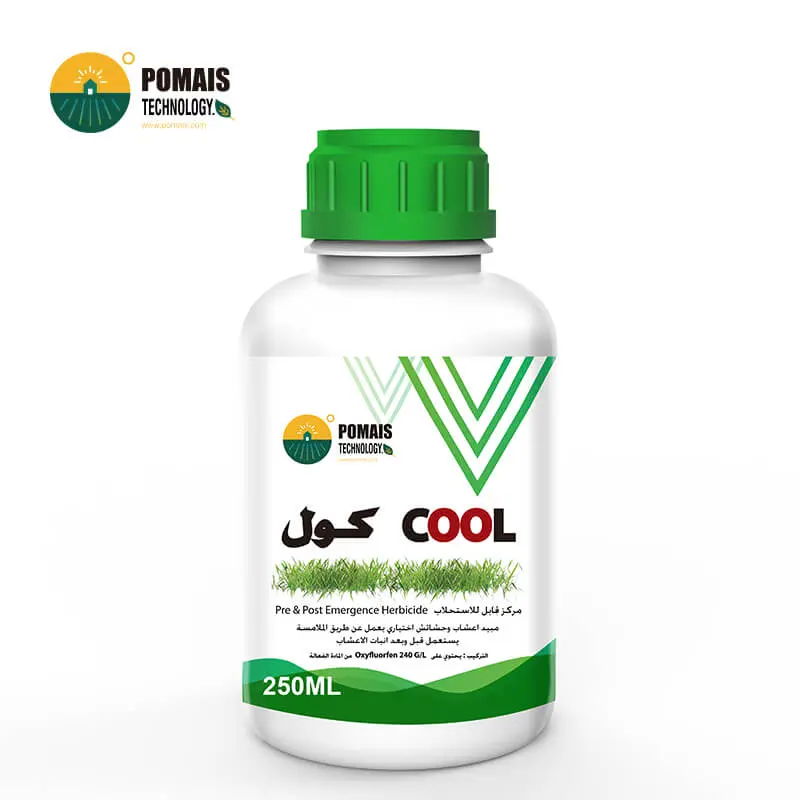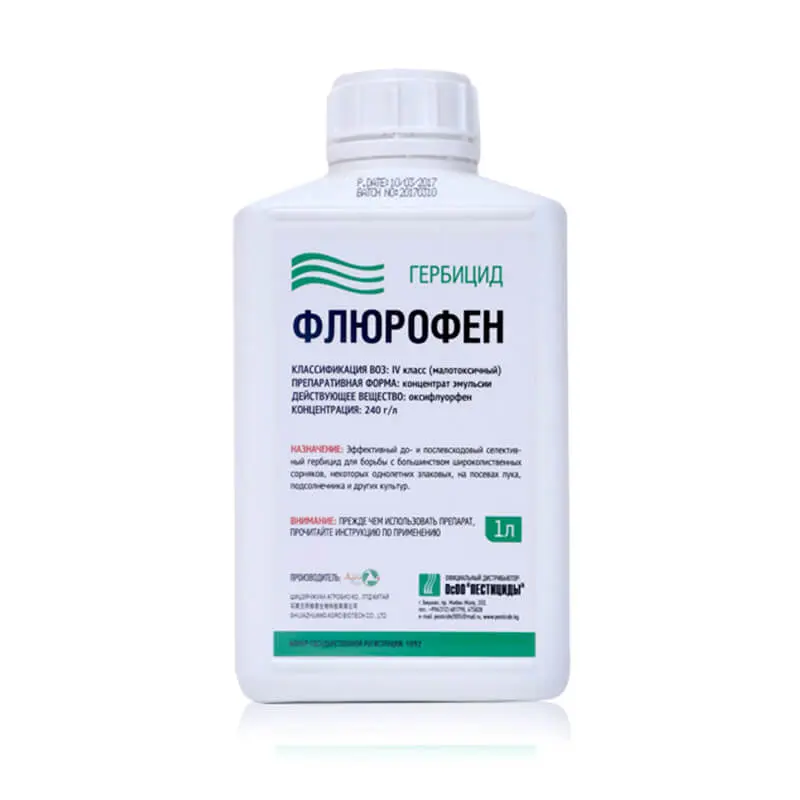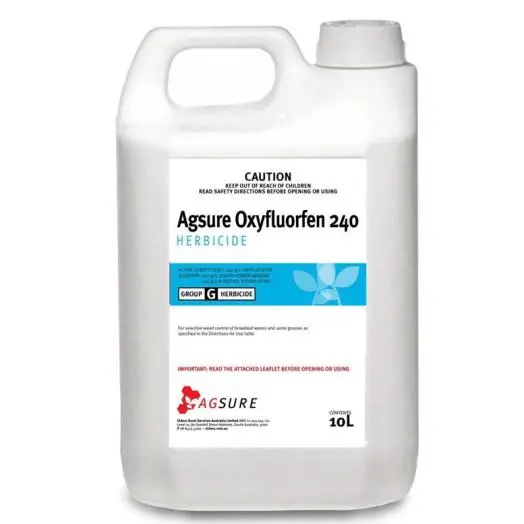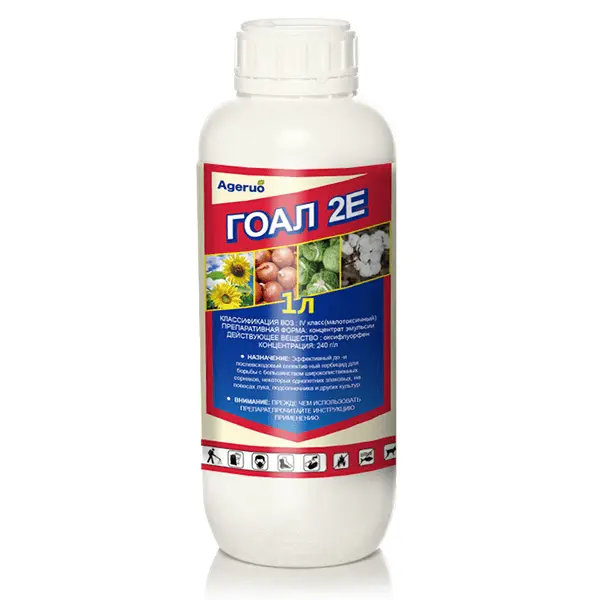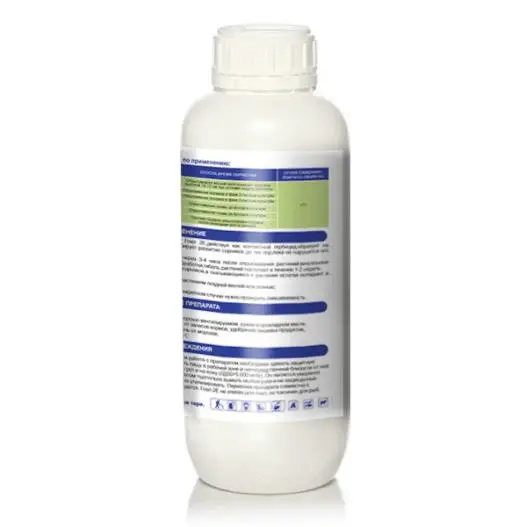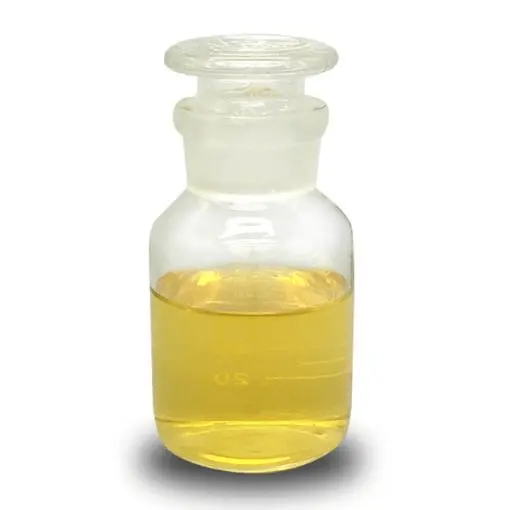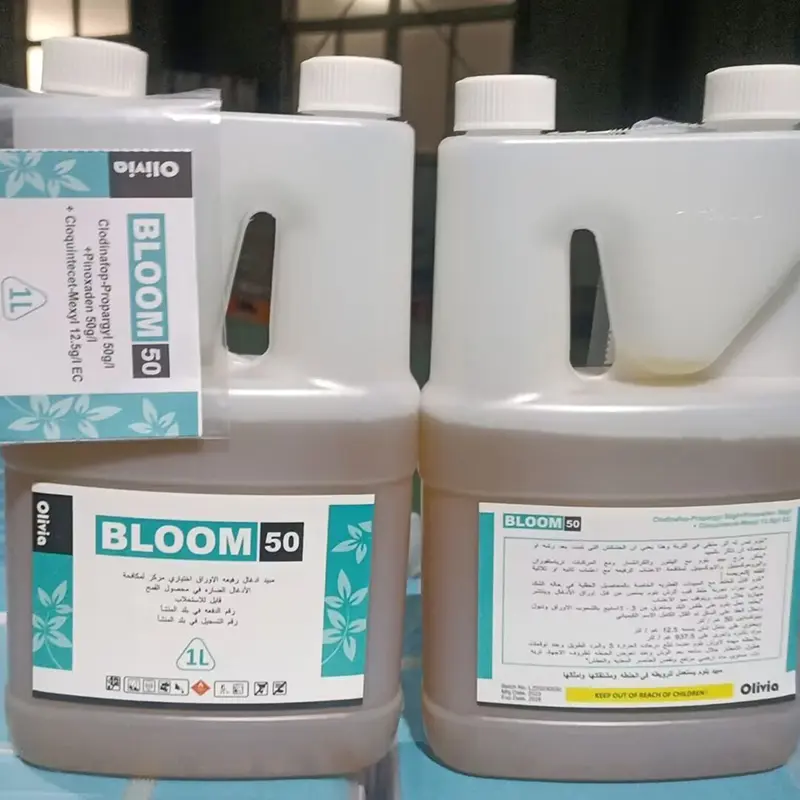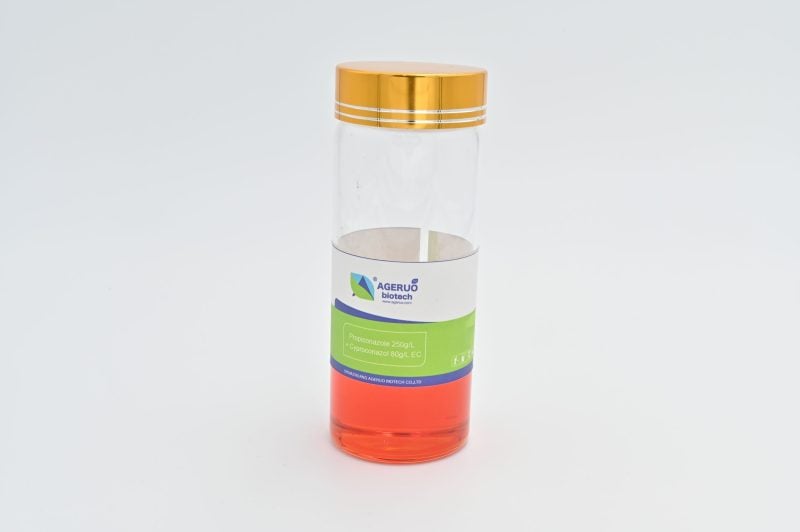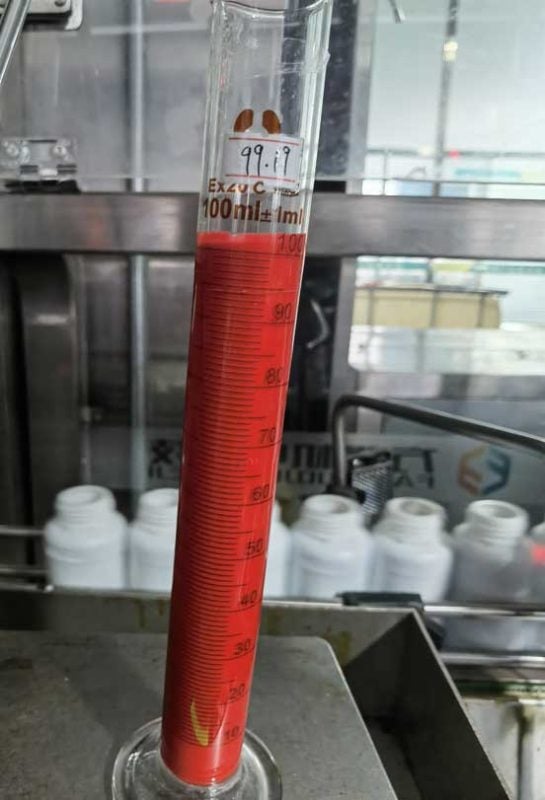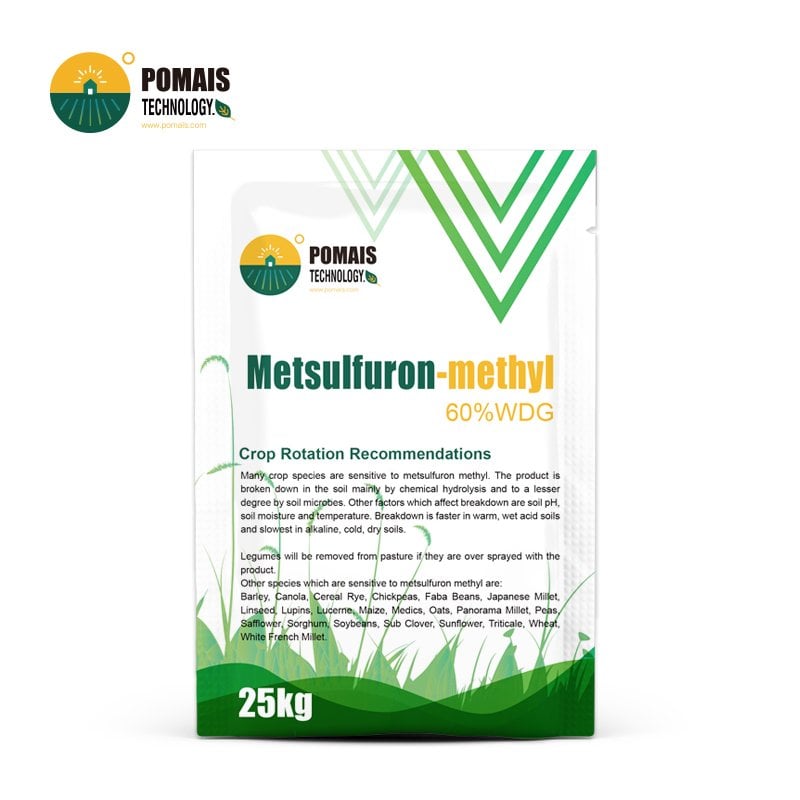Oxyfluorfen Herbicide
Broad-Spectrum PPO Inhibitor for Weed Control
Oxyfluorfen is a selective contact herbicide widely used for the control of broadleaf and grassy weeds in crops such as rice, cotton, onions, soybeans, and fruit trees. As a PPO inhibitor, it disrupts chlorophyll formation during weed germination, leading to cell membrane damage and effective weed suppression. It is suitable for both pre- and early post-emergence applications.
With multiple formulation options including EC, SC, and granular types, Oxyfluorfen offers flexible application across different soil types and cropping systems. It remains active even after rainfall and integrates well into Integrated Weed Management (IWM) programs.
Available in bulk for professional buyers and distributors, POMAIS supports:
-
OEM/ODM herbicide formulation and packaging
-
Custom labeling and branding
-
COA, MSDS, TDS, and registration support
Oxyfluorfen is ideal for importers, brand owners, and agrochemical suppliers looking for a reliable pre-emergent herbicide with proven efficacy and strong market adaptability.
- Designed for Professional Buyers & Bulk Orders
- This product is available for business purchase and large-scale distribution.
- We support custom packaging, labeling, and formulation to meet your market needs.
- Let’s build your brand together.

About Oxyfluorfen Herbicide
About Oxyfluorfen Herbicide
| Product Name | Oxyfluorfen |
| Chemical Name | 2-chloro-1-(3-ethoxy-4-nitrophenoxy)-4-(trifluoromethyl)benzene |
| CAS Number | 42874-03-3 |
| Chemical Formula | C15H11ClF3NO4 |
| Formulations Available | Oxyfluorfen 20% EC Oxyfluorfen 22.40% EC Oxyfluorfen 24% EC Oxyfluorfen 240 g/L EC Oxyfluorfen 32% EC Oxyfluorfen 5% SC Oxyfluorfen 25% SC Oxyfluorfen 35% SC Oxyfluorfen 480 g/L SC |
| Target Weeds | Annual and perennial weeds (e.g., foxtail, pigweed, barnyardgrass, sesbania, mandrake) |
| Suitable Crops | Rice, cotton, corn, peanuts, soybeans, vineyards, vegetables, onions, fruit trees |
| Toxicity | Moderate to high for bees and aquatic life; caution advised near pollinator areas |
| Mode of Action | Inhibits protoporphyrinogen oxidase (PPO), disrupting chlorophyll synthesis and causing cell damage |
| Shelf Life | 2 years |
Oxyfluorfen
Oxyfluorfen is a broad-spectrum selective herbicide used to control annual and perennial broadleaf and grassy weeds. It is applied as a pre-emergent or early post-emergent treatment to stop weed growth during or shortly after germination. The active ingredient works by inhibiting protoporphyrinogen oxidase (PPO), disrupting chlorophyll synthesis and causing rapid necrosis in weed tissue.
Available in a variety of formulations such as 20% EC, 24% EC, 25% SC, and granular types, Oxyfluorfen is suitable for use on key crops including rice, onions, cotton, peanuts, soybeans, corn, vegetables, and fruit trees.
With low water solubility and high residual soil activity, it performs well in both dry and humid conditions, making it a reliable option across different regions.
POMAIS supplies this herbicide in bulk with full OEM/ODM customization, including private label branding, packaging design, and formulation flexibility to meet regional regulatory standards. Whether you are managing a national brand or expanding distribution, Oxyfluorfen provides proven effectiveness with adaptable supply.
Active Ingredient & Formulation Options
Oxyfluorfen is an efficient PPO-inhibiting herbicide that works by disrupting chlorophyll biosynthesis in susceptible weeds. Its strong contact action and soil residual effect make it a reliable choice for both pre-emergent and early post-emergent applications.
Available Formulations
POMAIS offers a wide range of Oxyfluorfen formulations to meet specific crop and regional needs:
- Oxyfluorfen 20% EC / 22.4% EC / 24% EC / 240 g/L EC / 32% EC
- Oxyfluorfen 5% SC / 25% SC / 35% SC / 480 g/L SC
- Oxyfluorfen 2% Granular / 95% TC (Technical Grade)
All formulations are available for custom packaging, including bottle size, cap type, and multilingual label design. Custom formulation ratios can also be arranged to suit regional registration standards or climatic requirements.
Mode of Action
Oxyfluorfen functions as a protoporphyrinogen oxidase (PPO) inhibitor, targeting a critical step in the chlorophyll biosynthesis pathway. By inhibiting PPO enzymes in plant cells, Oxyfluorfen disrupts the conversion of protoporphyrinogen IX to protoporphyrin IX, leading to an accumulation of toxic intermediates. These intermediates generate reactive oxygen species under light exposure, damaging cell membranes and causing rapid necrosis in weed tissue.
This mechanism is particularly effective against young, germinating weeds that are highly vulnerable to metabolic disruption. Unlike systemic herbicides, Oxyfluorfen acts at the site of contact, making precise application essential for optimum performance.
Key Characteristics of Oxyfluorfen’s Mode of Action:
- Fast-acting: Causes visible injury within hours of exposure
- Light-activated: Requires sunlight for oxidative reactions, ensuring action only on exposed weed parts
- Effective in Pre- and Post-Emergence: Interrupts weed establishment at germination and early growth stages
- Useful in Resistance Management: Offers an alternative mode of action to ALS, EPSP, or ACCase inhibitors
Its mode of action makes Oxyfluorfen herbicide a valuable tool in integrated weed control strategies, especially when rotated with herbicides of different modes of action to delay resistance development.
Target Weeds & Suitable Crops
Oxyfluorfen provides effective control of a broad spectrum of annual and perennial weeds, including both monocotyledonous grasses and dicotyledonous broadleaf weeds. It is widely adopted across a variety of row crops, horticultural crops, and perennial plantations, offering flexible weed control for both pre-emergence and early post-emergence stages.
Common Weeds Controlled:
- Grasses: Barnyardgrass, foxtail, crabgrass
- Broadleaf weeds: Pigweed, lambsquarters, sesbania, purslane, amaranth, mandrake
- Sedges (with tank mix): Yellow nutsedge, purple nutsedge
Suitable Crops:
Oxyfluorfen has been successfully used in the following crops:
| Crop Category | Examples |
|---|---|
| Cereals & Grains | Rice, corn, wheat |
| Legumes | Soybeans, peanuts |
| Vegetables | Onions, garlic, tomatoes, leafy greens |
| Fruit Crops | Citrus, grapes, apples, mango |
| Industrial Crops | Cotton, sugarcane |
| Others | Forestry nurseries, vineyards |
The herbicide’s low mobility and long soil residual effect make it especially valuable in transplanted rice, onion fields, and orchards, where early weed pressure can reduce yield and quality.
Oxyfluorfen’s wide crop compatibility and effective weed control make it a practical choice for diversified farms and multi-crop distributors.
Application & Recommended Dosage
Oxyfluorfen herbicide should be applied during pre-emergence or early post-emergence stages, depending on the crop and target weed species. It offers both foliar contact action and soil residual control, ensuring prolonged weed suppression when applied correctly.
Recommended Usage by Formulation
| Formulation | Target Crop(s) | Target Weeds | Dosage Range | Application Method |
|---|---|---|---|---|
| Oxyfluorfen 23.5% EC | Rice, Cotton, Corn | Annual grasses, pigweed, barnyardgrass | 25–30 mL/ha | Foliar spray (pre-emergence) |
| Oxyfluorfen 24% EC | Onions, Peanuts, Fruit trees | Foxtail, mandrake, sesbania | 20–40 mL/ha | Foliar or soil spray |
| Oxyfluorfen 2% Granular | Orchards, Corn | Broadleaf weeds, foxtail | 0.5–1 kg/ha | Even soil broadcasting |
| Oxyfluorfen 25% SC | Vegetables, Sugarcane | Annual and perennial weeds | 200–400 mL/ha | Foliar or soil application |
| Oxyfluorfen 95% TC | Cotton, Soybeans, Fruit trees | Broad-spectrum weed control (mixed use) | Variable; refer to dilution | Soil treatment or tank mixing |
Application Tips:
- Apply before or during weed emergence when soil moisture is sufficient.
- Use flat-fan nozzles for uniform coverage.
- Avoid application on waterlogged fields or during heavy rain forecasts.
- Do not spray directly onto crops unless listed as safe in regional guidelines.
Soil Adjustment Considerations:
- On sandy soils, use lower dosage rates to prevent phytotoxicity.
- On clay or loamy soils, higher rates may be necessary to achieve full residual effect.
Proper application and adherence to label recommendations ensure maximum weed control with minimal risk to crops or the environment.
Key Advantages of Oxyfluorfen Herbicide
Long-Lasting Residual Control
Oxyfluorfen provides extended soil activity, effectively preventing weed emergence over a prolonged period. This reduces the frequency of re-application and improves labor efficiency in large-scale operations.
Broad-Spectrum Efficacy
It controls a wide variety of annual and perennial weeds, including hard-to-manage species such as barnyardgrass, foxtail, pigweed, and sesbania. Its action on both grasses and broadleaf weeds supports simplified weed control programs.
Flexible Formulation Options
Available in EC, SC, and granular forms, Oxyfluorfen can be tailored to local farming practices, soil types, and crop systems. This versatility makes it suitable for use in rice paddies, orchards, vegetable fields, and row crops.
Excellent Rainfastness
Due to its low solubility in water, Oxyfluorfen remains effective even after rainfall, ensuring consistent performance in humid or irrigation-dependent regions.
Compatibility with Other Herbicides
Oxyfluorfen can be tank-mixed with herbicides such as pendimethalin, sulfentrazone, or isoxaben to expand weed control range or manage herbicide resistance.
Ideal for Integrated Weed Management (IWM)
Its distinct mode of action (PPO inhibition) makes it valuable in IWM programs, especially where resistance to ALS, EPSPS, or ACCase inhibitors has been reported.
Whether used alone or as part of a weed control rotation plan, Oxyfluorfen herbicide offers the performance, adaptability, and consistency that professional growers and distributors demand.
Packaging & OEM/ODM Customization
At POMAIS, we understand the importance of presentation, compliance, and brand identity in agrochemical distribution. That’s why our Oxyfluorfen herbicide solutions come with full OEM and ODM customization services, tailored to meet your local market demands and regulatory standards.
Packaging Options:
- Bottle Sizes: 100 ml, 250 ml, 500 ml, 1 L, 5 L, 20 L (or customized)
- Materials: HDPE, PET, aluminum bottles, or customized containers
- Cap Types: Screw caps, sealed induction caps, childproof caps
- Labeling: Multilingual printing, weather-resistant labels, QR/barcode support
OEM/ODM Services:
- Private Label Printing: Launch your own branded herbicide line
- Formulation Customization: Adjust concentration or co-formulate with other actives
- Regulatory Support: Provide COA, MSDS, TDS, and local registration dossiers
- Batch Production: Flexible MOQs and scalable delivery schedules for seasonal demands
Export Packaging:
- UN-Certified Packaging for international chemical transport
- Palletized and shrink-wrapped for container safety
- Documentation support for Africa, Middle East, South America, Southeast Asia, and more
Whether you are building a new product portfolio or expanding your herbicide range, POMAIS offers reliable production, regulatory assistance, and end-to-end packaging services to help you compete in your local market with confidence.
Storage & Safety Instructions
Proper handling and storage of Oxyfluorfen herbicide are critical to maintaining product stability, ensuring user safety, and preventing environmental contamination. Please follow the guidelines below for safe and effective use.
Storage Conditions:
- Store in a cool, dry, and well-ventilated warehouse
- Keep away from direct sunlight, heat sources, and open flames
- Avoid freezing temperatures and excessive humidity
- Do not store near food, feed, seed, or potable water
Handling Precautions:
- Wear suitable PPE: gloves, protective clothing, goggles, and respirator when mixing or spraying
- Do not eat, drink, or smoke while handling the product
- Wash hands, arms, and face thoroughly after application
- Keep the product out of reach of children and untrained personnel
First Aid & Emergency Response:
- Skin contact: Wash with soap and water
- Eye contact: Rinse thoroughly with clean water for at least 15 minutes
- Inhalation: Move the person to fresh air and seek medical advice
- Ingestion: Do not induce vomiting; seek immediate medical attention with product label or MSDS in hand
Environmental Cautions:
- Avoid drift into water bodies, bee hives, or pollinator zones
- Do not apply in heavy rain or waterlogged conditions
- Dispose of empty containers safely—triple rinse and follow local pesticide waste regulations
Oxyfluorfen is classified as moderately hazardous to aquatic life and bees. Always refer to regional pesticide management guidelines and the Material Safety Data Sheet (MSDS) for detailed safety instructions.
Market Suitability & Regional Application
Oxyfluorfen herbicide is widely applicable across diverse cropping systems and environmental conditions, making it a practical solution for distributors and brand owners operating in different agricultural markets. Its broad-spectrum control, rainfast performance, and versatile formulations allow it to adapt well to varying weed pressures and regulatory environments.
Regional Adaptability:
- Africa: Suitable for cotton, rice, and vegetable production zones, where early-season weed control is critical. Performs well in both rainfed and irrigated systems.
- South America: Commonly used in soybeans, sugarcane, and fruit crops for pre-emergent weed suppression. Effective under high humidity and varied soil conditions.
- Middle East: Recommended for onions, garlic, grapes, and citrus, with strong residual control even in arid and semi-arid zones.
- Southeast Asia: Extensively used in transplanted rice, sugarcane, and horticultural crops, where fast-acting, low-solubility herbicides are essential.
- Eastern Europe and CIS countries: Compatible with local weed species and crop systems including orchards, grains, and open-field vegetables.
Ideal For:
- National agrochemical distributors
- Private-label herbicide brands
- Government supply contracts
- Multinational sourcing and export programs
With regulatory experience in over 30 countries, POMAIS offers full documentation support and can assist with product registration, compliance, and logistics. Whether you’re expanding into a new region or optimizing an existing portfolio, Oxyfluorfen offers consistent performance and market adaptability.
Related Products You May Be Interested In
If you are sourcing Oxyfluorfen herbicide for weed control in high-value crops, you may also be interested in the following herbicide products from our portfolio, each offering unique weed control advantages and complementary application profiles.
1. Pendimethalin 30% EC / 33% EC
A pre-emergent herbicide targeting annual grasses and broadleaf weeds in rice, wheat, and soybeans. Often combined with Oxyfluorfen for broader weed spectrum and extended soil activity.
2. Sulfentrazone 48% SC
A contact and residual broad-spectrum herbicide effective on sedges, nutsedge, and resistant pigweed species. Suitable for use in soybeans, sugarcane, and peanuts.
3. Oxadiazon 25% EC
A selective pre-emergent herbicide for turf, ornamental crops, and rice fields. Works well on crabgrass, barnyardgrass, and purslane when applied before weed emergence.
4. Isoxaben 75% WDG
A soil-applied PPO inhibitor used in vineyards, orchards, and tree nurseries for long-lasting control of broadleaf weeds. Excellent tank-mix partner with Oxyfluorfen.
5. Glyphosate 41% SL / 62% IPA
A non-selective systemic herbicide for post-emergent weed control in non-crop areas and field preparation. Often used in rotation before applying selective herbicides like Oxyfluorfen.
Each of these products is available with customizable packaging, full OEM/ODM support, and technical documentation for import and registration. Contact our team to receive a full product catalog or formulation comparison guide.
FAQ: All About Oxyfluorfen Herbicide
| Product Name | Oxyfluorfen |
| Chemical Name | 2-chloro-1-(3-ethoxy-4-nitrophenoxy)-4-(trifluoromethyl)benzene |
| CAS Number | 42874-03-3 |
| Chemical Formula | C15H11ClF3NO4 |
| Formulations Available | Oxyfluorfen 20% EC Oxyfluorfen 22.40% EC Oxyfluorfen 24% EC Oxyfluorfen 240 g/L EC Oxyfluorfen 32% EC Oxyfluorfen 5% SC Oxyfluorfen 25% SC Oxyfluorfen 35% SC Oxyfluorfen 480 g/L SC |
| Target Weeds | Annual and perennial weeds (e.g., foxtail, pigweed, barnyardgrass, sesbania, mandrake) |
| Suitable Crops | Rice, cotton, corn, peanuts, soybeans, vineyards, vegetables, onions, fruit trees |
| Toxicity | Moderate to high for bees and aquatic life; caution advised near pollinator areas |
| Mode of Action | Inhibits protoporphyrinogen oxidase (PPO), disrupting chlorophyll synthesis and causing cell damage |
| Shelf Life | 2 years |
Oxyfluorfen
Oxyfluorfen is a broad-spectrum selective herbicide used to control annual and perennial broadleaf and grassy weeds. It is applied as a pre-emergent or early post-emergent treatment to stop weed growth during or shortly after germination. The active ingredient works by inhibiting protoporphyrinogen oxidase (PPO), disrupting chlorophyll synthesis and causing rapid necrosis in weed tissue.
Available in a variety of formulations such as 20% EC, 24% EC, 25% SC, and granular types, Oxyfluorfen is suitable for use on key crops including rice, onions, cotton, peanuts, soybeans, corn, vegetables, and fruit trees.
With low water solubility and high residual soil activity, it performs well in both dry and humid conditions, making it a reliable option across different regions.
POMAIS supplies this herbicide in bulk with full OEM/ODM customization, including private label branding, packaging design, and formulation flexibility to meet regional regulatory standards. Whether you are managing a national brand or expanding distribution, Oxyfluorfen provides proven effectiveness with adaptable supply.
Active Ingredient & Formulation Options
Oxyfluorfen is an efficient PPO-inhibiting herbicide that works by disrupting chlorophyll biosynthesis in susceptible weeds. Its strong contact action and soil residual effect make it a reliable choice for both pre-emergent and early post-emergent applications.
Available Formulations
POMAIS offers a wide range of Oxyfluorfen formulations to meet specific crop and regional needs:
- Oxyfluorfen 20% EC / 22.4% EC / 24% EC / 240 g/L EC / 32% EC
- Oxyfluorfen 5% SC / 25% SC / 35% SC / 480 g/L SC
- Oxyfluorfen 2% Granular / 95% TC (Technical Grade)
All formulations are available for custom packaging, including bottle size, cap type, and multilingual label design. Custom formulation ratios can also be arranged to suit regional registration standards or climatic requirements.
Mode of Action
Oxyfluorfen functions as a protoporphyrinogen oxidase (PPO) inhibitor, targeting a critical step in the chlorophyll biosynthesis pathway. By inhibiting PPO enzymes in plant cells, Oxyfluorfen disrupts the conversion of protoporphyrinogen IX to protoporphyrin IX, leading to an accumulation of toxic intermediates. These intermediates generate reactive oxygen species under light exposure, damaging cell membranes and causing rapid necrosis in weed tissue.
This mechanism is particularly effective against young, germinating weeds that are highly vulnerable to metabolic disruption. Unlike systemic herbicides, Oxyfluorfen acts at the site of contact, making precise application essential for optimum performance.
Key Characteristics of Oxyfluorfen’s Mode of Action:
- Fast-acting: Causes visible injury within hours of exposure
- Light-activated: Requires sunlight for oxidative reactions, ensuring action only on exposed weed parts
- Effective in Pre- and Post-Emergence: Interrupts weed establishment at germination and early growth stages
- Useful in Resistance Management: Offers an alternative mode of action to ALS, EPSP, or ACCase inhibitors
Its mode of action makes Oxyfluorfen herbicide a valuable tool in integrated weed control strategies, especially when rotated with herbicides of different modes of action to delay resistance development.
Target Weeds & Suitable Crops
Oxyfluorfen provides effective control of a broad spectrum of annual and perennial weeds, including both monocotyledonous grasses and dicotyledonous broadleaf weeds. It is widely adopted across a variety of row crops, horticultural crops, and perennial plantations, offering flexible weed control for both pre-emergence and early post-emergence stages.
Common Weeds Controlled:
- Grasses: Barnyardgrass, foxtail, crabgrass
- Broadleaf weeds: Pigweed, lambsquarters, sesbania, purslane, amaranth, mandrake
- Sedges (with tank mix): Yellow nutsedge, purple nutsedge
Suitable Crops:
Oxyfluorfen has been successfully used in the following crops:
| Crop Category | Examples |
|---|---|
| Cereals & Grains | Rice, corn, wheat |
| Legumes | Soybeans, peanuts |
| Vegetables | Onions, garlic, tomatoes, leafy greens |
| Fruit Crops | Citrus, grapes, apples, mango |
| Industrial Crops | Cotton, sugarcane |
| Others | Forestry nurseries, vineyards |
The herbicide’s low mobility and long soil residual effect make it especially valuable in transplanted rice, onion fields, and orchards, where early weed pressure can reduce yield and quality.
Oxyfluorfen’s wide crop compatibility and effective weed control make it a practical choice for diversified farms and multi-crop distributors.
Application & Recommended Dosage
Oxyfluorfen herbicide should be applied during pre-emergence or early post-emergence stages, depending on the crop and target weed species. It offers both foliar contact action and soil residual control, ensuring prolonged weed suppression when applied correctly.
Recommended Usage by Formulation
| Formulation | Target Crop(s) | Target Weeds | Dosage Range | Application Method |
|---|---|---|---|---|
| Oxyfluorfen 23.5% EC | Rice, Cotton, Corn | Annual grasses, pigweed, barnyardgrass | 25–30 mL/ha | Foliar spray (pre-emergence) |
| Oxyfluorfen 24% EC | Onions, Peanuts, Fruit trees | Foxtail, mandrake, sesbania | 20–40 mL/ha | Foliar or soil spray |
| Oxyfluorfen 2% Granular | Orchards, Corn | Broadleaf weeds, foxtail | 0.5–1 kg/ha | Even soil broadcasting |
| Oxyfluorfen 25% SC | Vegetables, Sugarcane | Annual and perennial weeds | 200–400 mL/ha | Foliar or soil application |
| Oxyfluorfen 95% TC | Cotton, Soybeans, Fruit trees | Broad-spectrum weed control (mixed use) | Variable; refer to dilution | Soil treatment or tank mixing |
Application Tips:
- Apply before or during weed emergence when soil moisture is sufficient.
- Use flat-fan nozzles for uniform coverage.
- Avoid application on waterlogged fields or during heavy rain forecasts.
- Do not spray directly onto crops unless listed as safe in regional guidelines.
Soil Adjustment Considerations:
- On sandy soils, use lower dosage rates to prevent phytotoxicity.
- On clay or loamy soils, higher rates may be necessary to achieve full residual effect.
Proper application and adherence to label recommendations ensure maximum weed control with minimal risk to crops or the environment.
Key Advantages of Oxyfluorfen Herbicide
Long-Lasting Residual Control
Oxyfluorfen provides extended soil activity, effectively preventing weed emergence over a prolonged period. This reduces the frequency of re-application and improves labor efficiency in large-scale operations.
Broad-Spectrum Efficacy
It controls a wide variety of annual and perennial weeds, including hard-to-manage species such as barnyardgrass, foxtail, pigweed, and sesbania. Its action on both grasses and broadleaf weeds supports simplified weed control programs.
Flexible Formulation Options
Available in EC, SC, and granular forms, Oxyfluorfen can be tailored to local farming practices, soil types, and crop systems. This versatility makes it suitable for use in rice paddies, orchards, vegetable fields, and row crops.
Excellent Rainfastness
Due to its low solubility in water, Oxyfluorfen remains effective even after rainfall, ensuring consistent performance in humid or irrigation-dependent regions.
Compatibility with Other Herbicides
Oxyfluorfen can be tank-mixed with herbicides such as pendimethalin, sulfentrazone, or isoxaben to expand weed control range or manage herbicide resistance.
Ideal for Integrated Weed Management (IWM)
Its distinct mode of action (PPO inhibition) makes it valuable in IWM programs, especially where resistance to ALS, EPSPS, or ACCase inhibitors has been reported.
Whether used alone or as part of a weed control rotation plan, Oxyfluorfen herbicide offers the performance, adaptability, and consistency that professional growers and distributors demand.
Packaging & OEM/ODM Customization
At POMAIS, we understand the importance of presentation, compliance, and brand identity in agrochemical distribution. That’s why our Oxyfluorfen herbicide solutions come with full OEM and ODM customization services, tailored to meet your local market demands and regulatory standards.
Packaging Options:
- Bottle Sizes: 100 ml, 250 ml, 500 ml, 1 L, 5 L, 20 L (or customized)
- Materials: HDPE, PET, aluminum bottles, or customized containers
- Cap Types: Screw caps, sealed induction caps, childproof caps
- Labeling: Multilingual printing, weather-resistant labels, QR/barcode support
OEM/ODM Services:
- Private Label Printing: Launch your own branded herbicide line
- Formulation Customization: Adjust concentration or co-formulate with other actives
- Regulatory Support: Provide COA, MSDS, TDS, and local registration dossiers
- Batch Production: Flexible MOQs and scalable delivery schedules for seasonal demands
Export Packaging:
- UN-Certified Packaging for international chemical transport
- Palletized and shrink-wrapped for container safety
- Documentation support for Africa, Middle East, South America, Southeast Asia, and more
Whether you are building a new product portfolio or expanding your herbicide range, POMAIS offers reliable production, regulatory assistance, and end-to-end packaging services to help you compete in your local market with confidence.
Storage & Safety Instructions
Proper handling and storage of Oxyfluorfen herbicide are critical to maintaining product stability, ensuring user safety, and preventing environmental contamination. Please follow the guidelines below for safe and effective use.
Storage Conditions:
- Store in a cool, dry, and well-ventilated warehouse
- Keep away from direct sunlight, heat sources, and open flames
- Avoid freezing temperatures and excessive humidity
- Do not store near food, feed, seed, or potable water
Handling Precautions:
- Wear suitable PPE: gloves, protective clothing, goggles, and respirator when mixing or spraying
- Do not eat, drink, or smoke while handling the product
- Wash hands, arms, and face thoroughly after application
- Keep the product out of reach of children and untrained personnel
First Aid & Emergency Response:
- Skin contact: Wash with soap and water
- Eye contact: Rinse thoroughly with clean water for at least 15 minutes
- Inhalation: Move the person to fresh air and seek medical advice
- Ingestion: Do not induce vomiting; seek immediate medical attention with product label or MSDS in hand
Environmental Cautions:
- Avoid drift into water bodies, bee hives, or pollinator zones
- Do not apply in heavy rain or waterlogged conditions
- Dispose of empty containers safely—triple rinse and follow local pesticide waste regulations
Oxyfluorfen is classified as moderately hazardous to aquatic life and bees. Always refer to regional pesticide management guidelines and the Material Safety Data Sheet (MSDS) for detailed safety instructions.
Market Suitability & Regional Application
Oxyfluorfen herbicide is widely applicable across diverse cropping systems and environmental conditions, making it a practical solution for distributors and brand owners operating in different agricultural markets. Its broad-spectrum control, rainfast performance, and versatile formulations allow it to adapt well to varying weed pressures and regulatory environments.
Regional Adaptability:
- Africa: Suitable for cotton, rice, and vegetable production zones, where early-season weed control is critical. Performs well in both rainfed and irrigated systems.
- South America: Commonly used in soybeans, sugarcane, and fruit crops for pre-emergent weed suppression. Effective under high humidity and varied soil conditions.
- Middle East: Recommended for onions, garlic, grapes, and citrus, with strong residual control even in arid and semi-arid zones.
- Southeast Asia: Extensively used in transplanted rice, sugarcane, and horticultural crops, where fast-acting, low-solubility herbicides are essential.
- Eastern Europe and CIS countries: Compatible with local weed species and crop systems including orchards, grains, and open-field vegetables.
Ideal For:
- National agrochemical distributors
- Private-label herbicide brands
- Government supply contracts
- Multinational sourcing and export programs
With regulatory experience in over 30 countries, POMAIS offers full documentation support and can assist with product registration, compliance, and logistics. Whether you’re expanding into a new region or optimizing an existing portfolio, Oxyfluorfen offers consistent performance and market adaptability.
Related Products You May Be Interested In
If you are sourcing Oxyfluorfen herbicide for weed control in high-value crops, you may also be interested in the following herbicide products from our portfolio, each offering unique weed control advantages and complementary application profiles.
1. Pendimethalin 30% EC / 33% EC
A pre-emergent herbicide targeting annual grasses and broadleaf weeds in rice, wheat, and soybeans. Often combined with Oxyfluorfen for broader weed spectrum and extended soil activity.
2. Sulfentrazone 48% SC
A contact and residual broad-spectrum herbicide effective on sedges, nutsedge, and resistant pigweed species. Suitable for use in soybeans, sugarcane, and peanuts.
3. Oxadiazon 25% EC
A selective pre-emergent herbicide for turf, ornamental crops, and rice fields. Works well on crabgrass, barnyardgrass, and purslane when applied before weed emergence.
4. Isoxaben 75% WDG
A soil-applied PPO inhibitor used in vineyards, orchards, and tree nurseries for long-lasting control of broadleaf weeds. Excellent tank-mix partner with Oxyfluorfen.
5. Glyphosate 41% SL / 62% IPA
A non-selective systemic herbicide for post-emergent weed control in non-crop areas and field preparation. Often used in rotation before applying selective herbicides like Oxyfluorfen.
Each of these products is available with customizable packaging, full OEM/ODM support, and technical documentation for import and registration. Contact our team to receive a full product catalog or formulation comparison guide.
FAQ: All About Oxyfluorfen Herbicide
Related Products
Latest News

